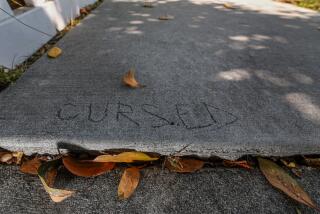Owners can begin to fix problems by attending board meetings
- Share via
Question: There’s an overall deterioration in our homeowners association, and we’re ashamed of the deplorable eyesores throughout the complex.
There are cracks in the concrete and plaster and peeling paint everywhere. All the trees need more soil as exposed roots are cause for liability. The stairs have ragged or missing safety strips; gates have ugly, dated signs; patio tables and pool furniture are filthy; and there are corroded and rotting wood trellises and dying foliage.
When this is relayed to the board, we get excuses such as, “The building is old” and “Major items wear out” such as the elevators, pool gunite and water heater boilers. We fax and email the association’s management company and do not get a response.
Association dues have increased through the years, and we’ve had assessments for water damage from lack of proper maintenance that the insurance company would not pay for. The board president is under pressure to ask homeowners for more money that no one wants to fork over, so she tightly controls funds that are necessary to make these improvements. Where do owners start to fix these problems?
Answer: Owners start to fix these problems by systematically attending board meetings en masse. Boards, not management companies, are vested with the legal obligation to repair and maintain the common property and must be willing to implement those repairs in a timely manner.
Owners fix problems with their association by electing a board that understands the need for ongoing maintenance while operating within the given budget. Things break, deteriorate or stop working, then have to be fixed.
In an association, the costs of those repairs are shared among all titleholders. At any given time, depending on the scope of repairs, the costs may be somewhat greater, but in the end, repairs have to be made and the costs have to be shared. Predictably, putting off inevitable repairs increases costs for all titleholders.
Unfortunately, collecting more money from owners does not guarantee the money will be used on repairs or that problems will be addressed.
Owners should put the board on notice that failure to make repairs is a potential liability to the association. If no visible progress occurs, individual owners or any group of owners may choose to enforce the board’s obligations to repair by filing a lawsuit against the association and its directors.
As the obligation to repair the common interest development property is typically included in the association’s covenants, conditions and restrictions, should the owners prevail, the court must award them their attorney fees.
Choosing realistic, cost-effective and well-thought-out and budgeted solutions for your association’s maintenance problems helps define long-term goals to get the complex repaired and keep it properly and regularly maintained.
The late Stephen Glassman, an attorney specializing in corporate and business law, co-wrote this column. Vanitzian is an arbitrator and mediator. Send questions to P.O. Box 10490, Marina del Rey, CA 90295 or noexit@mindspring.com.
More to Read
Inside the business of entertainment
The Wide Shot brings you news, analysis and insights on everything from streaming wars to production — and what it all means for the future.
You may occasionally receive promotional content from the Los Angeles Times.










